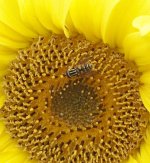Tyler Vargo said:
Correct me if I'm wrong but I think the "partial metering at the center of the image" is spot metering.
I don't thinks so, but that's why I'm asking. Digital Review says in a couple places that it isn't the same thing. It looks to me like "center-weighted" is as much as 75% of the subject area, whereas "partial metering at centre" is 9%, and spot metering is as little as 1%. The 20D, for example, definitely does have spot metering, as does my Fuji.
I tried some test shots yesterday of a white rose with pale pink and yellow details (Peace, if that means anything to anyone) in bright sun on dark green foliage at max zoom with a Tcon 17, trying to simulate a white bird on dark green foliage, with exposure compensation set at 0.0, -0.3, and -0.6. The rose was less than 1% of the frame at that distance and was the center of focus.
Both the Pattern and Multi metering failed to capture any detail at all in the white - it was way over-exposed - which is exactly what I expected.
Spot metering worked perfectly and picked up all the fine details at either -0.3 or -0.6, can't remember which, though the rose was on a very dark background of course.
With center metering at 9% I suspect this would be a very difficult subject to capture correctly, unless you got close enough to fill more of the center. You can't always do that with birds, which is why I'm wondering if this type of metering is adequate for birding.
If you buy a more expensive tele lens to compensate for the metering, then don't you end up spending just as much as if you bought a 20D in the first place? I'm on a budget and want to be realistic about how much it's actually going to cost to be satisfied with the performance of the EOS 350D vs something else.
A few references to "No spot metering" on the EOS 350D:
In "Conclusions - Cons" one of the items is
* No spot metering here:
http://www.dpreview.com/reviews/canoneos350d/page28.asp
And here from another review:
Light metering can be set to evaluative 35 zones, center-weighted or partial at 9% center. As with all lower class EOS cameras, the EOS 350D doesn't have spot metering.
http://www.e-fotografija.com/artman/publish/article_648.shtml
And finally here, comparing features to the Nikon D70:
Nikon D70 metering:
TTL full-aperture exposure metering system
3D color matrix metering with 1,005-segment RGB sensor
Center-weighted: Weight of 75% given to 6, 8, 10, or 13-mm circle in center of frame (variable through custom functions)
Spot: Meters about 1% of frame centered on active focus area
Canon Digital Rebel XT / 350D:
TTL full aperture exposure metering
35-zone SPC (1) 35 Point Evaluative (linked to all AF points)
Partial metering at centre (approx. 9% of viewfinder)
Centre weighted
http://www.digitalreview.ca/cams/NikonD70versusRebelXT.shtml





